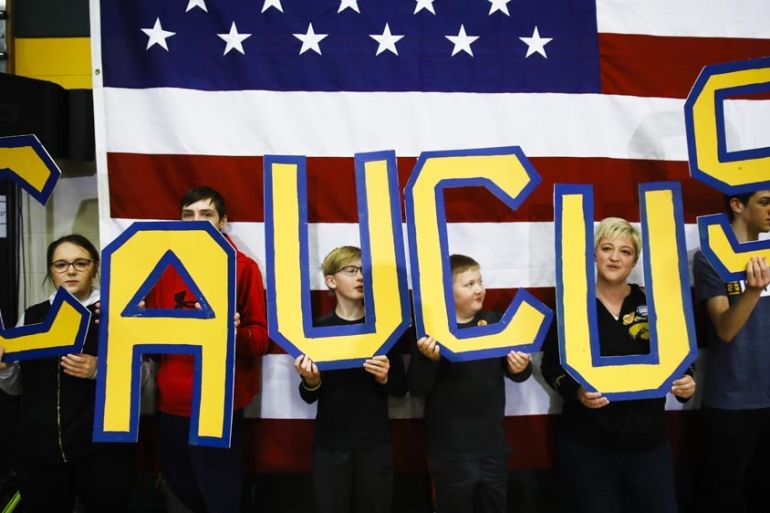US election 2020: What are presidential primaries and caucuses?
The start of the caucus and primary season gets under way on Monday. Here’s what you need to know.

Amid an impeachment trial and escalating tensions between the United States and other countries, including in the Middle East, the US presidential election have officially kicked into high gear.
Things will move even quicker after Monday, when the presidential primary season officially gets under way in Iowa.
Keep reading
list of 3 itemsUS elections 2020: When are the debates, primaries, conventions?
What can the 2019 election results tell us about 2020?
By mid-July, the Democrats will choose who will face – barring any wildly unforeseen developments between now and then – Republican President Donald Trump in the November 3 general election.
The voters’ preference will be determined through a series of early primaries and caucuses held by both the Republican and Democratic parties in each of the 50 states. The Republican primaries that actually take place (seven states have already cancelled them) are largely irrelevant. Democrats, on the other hand, have 11 candidates to choose from.

The US is unusual in allowing for these first-round votes, relying on primaries or caucuses to direct delegates who will choose their party’s candidate.
Presidential primaries only became a thing in the 1970s, and most states and several overseas US territories hold them, beginning with New Hampshire on February 11, 2020.
Four states – Iowa, Nevada, North Dakota and Wyoming – will hold caucuses this year.
What are caucuses?
A handful of states hold caucuses instead of state-run official elections held at an official polling place, which is the case in primaries. Caucuses are small private gatherings in churches, schools, libraries or even members’ private homes where party members openly express their preference for one candidate over another.
Critics of caucuses said they tend to exclude marginal voices and favour only the most engaged and informed voters. Proponents say it allows party members to engage with each other. But the number of states and US territories this year is far fewer than in years past. In 2016, 18 states and territories conducted caucuses.

In Iowa, there are more than 1,600 traditional precinct caucus sites and 87 “satellite” locations, including mosques and sites outside the state.
What are primaries?
A primary is a government-managed election with secret ballots, election officials and “I Voted” stickers. Citizens decide which party best represents their views and opt to help select that party’s candidate for the general election. Some states’ primaries are open, in which case voters can decide even at the last minute which party’s primary they will vote in – although never both – and some are closed, meaning that only voters who had registered with a specific party before election day can vote in that party’s primary.

New Hampshire has held the first presidential primary since 1920 and is bound by state law to continue doing so regardless of what other states do. Its primary this year will be held on February 11.
Why are there both caucuses and primaries?
Primaries are not required by the US Constitution. States and party leaders have developed the systems over time. They emerged out of the Progressive Era of the early 20th century when reformers became tired of corrupt party leaders picking political candidates for the wrong reasons. The idea was widely adopted for state and local races almost immediately, but only came into widespread use in presidential elections during the early 1970s when the Republican and Democratic parties changed the rules about how convention delegates are apportioned to the candidates.
What are people voting for?
Primary voters are not voting directly for a candidate even if, on paper, that’s what seems to be happening. Instead, how they vote determines how each state’s delegates are divided up among the candidates during each party’s nominating convention. The delegates are actually the ones who choose the nominee.

This year, the Democratic convention is in July in Milwaukee, Wisconsin. The Republican convention is in August in Charlotte, North Carolina.
The primaries in most states are binding, meaning that most of the state’s delegates are obligated to vote for a particular candidate depending on the earlier vote tally.
Why do primaries and caucuses matter?
The obvious answer is that future US presidents are based on the outcomes of primaries and caucuses. There are, however, other reasons. First, they give voters a chance to hear from any number of different people, who all may have different ideas, before the field is narrowed to just two for the general election.
Second, primaries can help mold a party’s platform on the issues. If a candidate that championed climate change above all else during the primaries fared particularly well, the odds are greater that climate change will be near the top of that party’s agenda. Lastly, primaries are a good proving ground for unconventional wisdom. In 1960, Democrats were convinced that southern voters would never vote for a Roman Catholic candidate. John F Kennedy’s win over Hubert Humphrey in the West Virginia primary proved otherwise, and party leader rallied behind the young man from Massachusetts.
